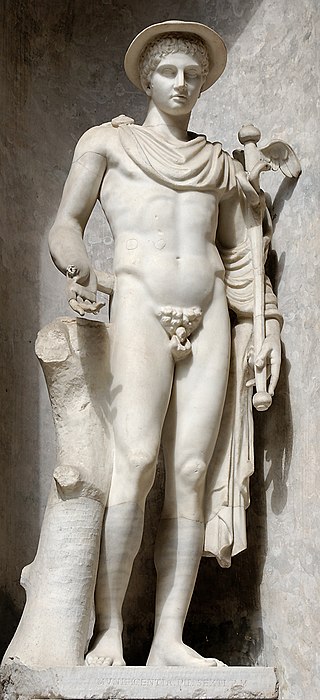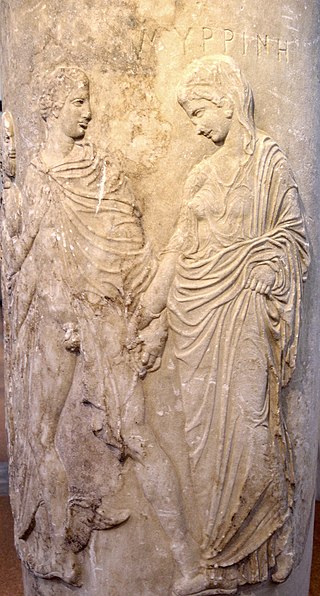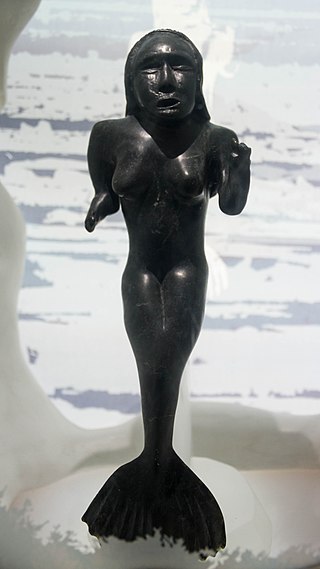Related Research Articles

Anubis, also known as Inpu, Inpw, Jnpw, or Anpu in Ancient Egyptian, is the god of funerary rites, protector of graves, and guide to the underworld, in ancient Egyptian religion, usually depicted as a canine or a man with a canine head.

Hermes is an Olympian deity in ancient Greek religion and mythology considered the herald of the gods. He is also widely considered the protector of human heralds, travelers, thieves, merchants, and orators. He is able to move quickly and freely between the worlds of the mortal and the divine aided by his winged sandals. Hermes plays the role of the psychopomp or "soul guide"—a conductor of souls into the afterlife.

In Greek mythology, Charon or Kharon is a psychopomp, the ferryman of the Greek underworld. He carries the souls of those who have been given funeral rites across the rivers Acheron and Styx, which separate the worlds of the living and the dead. Archaeology confirms that, in some burials, low-value coins known generically as Charon's obols were placed in, on, or near the mouth of the deceased, or next to the cremation urn containing their ashes. This has been taken to confirm that at least some aspects of Charon's mytheme are reflected in some Greek and Roman funeral practices, or else the coins function as a viaticum for the soul's journey. In Virgil's epic poem, Aeneid, the dead who could not pay the fee, and those who had received no funeral rites, had to wander the near shores of the Styx for one hundred years before they were allowed to cross the river. Charon also ferried the living mortals Heracles and Aeneas to the underworld and back again.

Psychopomps are creatures, spirits, angels, demons, or deities in many religions whose responsibility is to escort newly deceased souls from Earth to the afterlife.

Inuit religion is the shared spiritual beliefs and practices of the Inuit, an indigenous people from Alaska, northern Canada, parts of Siberia, and Greenland. Their religion shares many similarities with some Alaska Native religions. Traditional Inuit religious practices include animism and shamanism, in which spiritual healers mediate with spirits. Today many Inuit follow Christianity ; however, traditional Inuit spirituality continues as part of a living, oral tradition and part of contemporary Inuit society. Inuit who balance indigenous and Christian theology practice religious syncretism.

Mictlan is the underworld of Aztec mythology. Most people who die would travel to Mictlan, although other possibilities exist. Mictlan consists of nine distinct levels.
In Inuit mythology, Idliragijenget is the god of the ocean.
As Idliragijenget, she is the ruler of the underworld, Adlivun. She and her father Savirqong occupy opposite sides of a large house. Since their apotheosis, they must live in the same place but keep apart that summer and winter may not get mixed...Like his daughter, he has but one eye,—the moon. The dead, seized by Anguta, are carried thither.
Sedna is the mistress of one of the countries to which the souls go after death. It has been related in the foregoing tradition of Sedna and the fulmar that she descended to Adlivun; since that time she has been the mistress of the country and when invoked as such has the name of Idliragijenget...There she lives with her father, each occupying one side of it...Like her, the father has only one eye.

Sedna is the goddess of the sea and marine animals in Inuit religion, also known as the Mother of the Sea or Mistress of the Sea. The story of Sedna, which is a creation myth, describes how she came to rule over Adlivun, the Inuit version of the underworld. In sculptures, Sedna is often depicted with the head and upper body of a woman and the tail of a marine mammal, similar to a mermaid.
In Inuit religion, Adlivun are the spirits of the departed who reside in the underworld, and by extension the underworld itself, located beneath the land and the sea. The souls are purified there, in preparation for the travel to the Land of the Moon, where they find eternal rest and peace. Sedna, Torngarsuk and the tornat and tupilaq live in Adlivun, which is usually described as a frozen wasteland. Sedna is the ruler of the land, and is said to imprison the souls of the living as part of the preparation for the next stage of their journey.
The Adlet are a race of creatures in the Inuit mythology of Greenland, as well as the Labrador and Hudson Bay coasts. While the word refers to inland native American tribes, it also denotes a humanoid dog-legged tribe. The lower part of the body of the canine Adlet is like that of a dog and their upper part is like a man's. All Adlet run quickly, and their encounters with men usually end with man as the victor.

Yama is the Hindu deity of death, dharma, the south direction, and the underworld. Belonging to an early stratum of Rigvedic Hindu deities, Yama is said to have been the first mortal who died in the Vedas. By virtue of precedence, he became the ruler of the departed.

The Indigenous peoples of the Americas comprise numerous different cultures. Each has its own mythologies, many of which share certain themes across cultural boundaries. In North American mythologies, common themes include a close relation to nature and animals as well as belief in a Great Spirit that is conceived of in various ways. As anthropologists note, their great creation myths and sacred oral tradition in whole are comparable to the Christian Bible and scriptures of other major religions.

Traditional Sámi spiritual practices and beliefs are based on a type of animism, polytheism, and what anthropologists may consider shamanism. The religious traditions can vary considerably from region to region within Sápmi.

The Inuit angakkuq is an intellectual and spiritual figure in Inuit culture who corresponds to a medicine man. Other cultures, including Alaska Natives, have traditionally had similar spiritual mediators, although the Alaska Native religion has many forms and variants.

In Celtic mythology, the Otherworld is the realm of the deities and possibly also the dead. In Gaelic and Brittonic myth it is usually a supernatural realm of everlasting youth, beauty, health, abundance and joy. It is described either as a parallel world that exists alongside our own, or as a heavenly land beyond the sea or under the earth. The Otherworld is usually elusive, but various mythical heroes visit it either through chance or after being invited by one of its residents. They often reach it by entering ancient burial mounds or caves, or by going under water or across the western sea. Sometimes, they suddenly find themselves in the Otherworld with the appearance of a magic mist, supernatural beings or unusual animals. An otherworldly woman may invite the hero into the Otherworld by offering an apple or a silver apple branch, or a ball of thread to follow as it unwinds.
Estonian mythology is a complex of myths belonging to the Estonian folk heritage and literary mythology. Information about the pre-Christian and medieval Estonian mythology is scattered in historical chronicles, travellers' accounts and in ecclesiastical registers. Systematic recordings of Estonian folklore started in the 19th century. Pre-Christian Estonian deities may have included a god known as Jumal or Taevataat in Estonian, corresponding to Jumala in Finnish, and Jumo in Mari.

In the Inuit religion, Torngarsuk is a sea, death and underworld god, one of the more important deities in the Inuit pantheon. He is said to be the leader of the Tornat, a group of protective gods.
Ossetian mythology or Alan mythology is the collective term for the beliefs and practices of the Ossetian people of the Caucasus region, which contains several gods and supernatural beings. The religion itself is believed to be of Scythian origin, but contains many later elements from Christianity, with Ossetian gods often being identified with Christian saints. The gods play a role in the famous stories about a race of semi-divine heroes called the Narts.

A liminal deity is a god or goddess in mythology who presides over thresholds, gates, or doorways; "a crosser of boundaries". These gods are believed to oversee a state of transition of some kind; such as, the old to the new, the unconscious to the conscious state, the familiar to the unknown.
References
- ↑ Turner, Frederick (Summer 1992). "Bloody Columbus: Restoration and the Transvaluation of Shame into Beauty". Restoration and Management Notes. 10 (1). University of Wisconsin Press: 70–74. JSTOR 43439976.
- ↑ Leeming, David (2021). Tales of the Earth: Native North American Creation Mythology. Reaktion Books. ISBN 9781789145007.
- 1 2 Wardle, H. Newell (1900). "The Sedna Cycle: A Study in Myth Evolution". American Anthropologist. 2 (3). American Anthropological Association: 568–580. doi: 10.1525/aa.1900.2.3.02a00100 . JSTOR 658969.
- ↑ Falkner, David E. (2020). Hubbell, Gerald R. (ed.). The Mythology of the Night Sky. Springer. p. 184. ISBN 978-3-030-47693-9.
- ↑ Joel Rudinger (Mar 26, 2009). "The Path to Sedna". Young Adult Literature and Culture. Cambridge Scholars Publishing. p. 52. ISBN 9781443807326.
- ↑ McMahon-Coleman, Kimberley (2006). "Dreaming an Identity between Two Cultures: The Works of Alootook Ipellie". Kunapipi. 28 (1): 120.